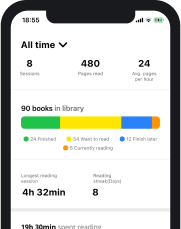As readers, we often tend to take this activity and all of its subtle variations for granted. While that is easily understandable considering how second-nature reading has become for most of us, there is no denying the fact that not paying attention to all the different types of reading would be a mistake. Superficial reading sounds like something that we should generally avoid, but is that really the case?
Here at Basmo, we believe that reading is something that should not only be done but also truly explored and taken advantage of. That being said, let’s have a look at what superficial reading is, what it can help with, and why you should consider it as a reading strategy, at least from time to time.
So, what does superficial reading mean?
What is superficial reading?
Superficial reading is a useful technique for people who only need to gain a vague idea of what the text is about and don’t need to read every single word and analyze the book or reading material in detail. The superficial reading definition classifies this technique as a speed reading strategy that involves skimming over the content at hand without going too deep into the meaning of it.
There needs to be a clear distinction made between being a superficial reader in general and using superficial reading as a tool that works to your advantage. There is a fine line readers need to walk in order to maintain their reading habits healthy and productive as soon as they start using superficial reading.
That’s because while sometimes skimming or reading superficially is something that will benefit you in the end, other times you can fall into a trap. Reading superficially can backfire quite easily if you don’t use it the right way. Don’t worry, more on this will follow.
But first, let’s explore where superficial reading falls within the different levels or forms of reading. As you may know, there are four main levels of reading:
- Elementary reading
- Inspectional reading
- Analytical reading
- Syntopical reading
Each of these levels defines a different set of abilities a reader possesses and actions he can perform. Superficial reading is a part of the second level, inspectional reading. This level refers to the process of pre-reading or skimming a text or book before actually reading it. The last part is quite important and makes the difference between superficial reading being a positive or a negative habit. When superficial reading precedes an active reading session, it is fully justified and beneficial. Superficial reading alone, as a reading habit, is definitely something you should avoid.
The goal of a superficial reading session is to get some idea of the content at hand, to extract a couple of the main ideas, and to gather just some relevant information from the text. For example, you could do some superficial reading to make sure a book you are about to read contains the information you are looking for and determine whether reading it in detail is worth the effort considering what your ultimate goal is.
How to do superficial reading? A Step-by-step guide to superficial reading.
Now that the superficial reading meaning is clear, it’s time to take a look at how this strategy should be implemented and used for the best results. Even though it may sound like something that can be easily done with no instructions, it is of utmost importance that we treat it just as we would any other reading strategy.
After all, everyone can read superficially, right? Well, to a certain extent, yes. But in order to yield the best possible results in each reading session, there’s a little more that needs to go into the process. Here’s how you should use superficial reading as a strategy:
- Establish your goal. In order for your superficial reading session to be successful, the first thing you need to know is exactly why you are engaging in this activity. What are you looking to achieve? What do you expect to know about the book or reading material after you’ve finished reading it superficially? This is where you should use pre-reading to determine whether the information you need is in the book at hand, whether the book is worth reading or not, and how you plan to achieve other goals later in your reading session (through active or deep reading).
- Preview the content. Now that you know why you are doing this, it’s time to have a look at the text you’re planning to explore. Check the title, some headings or chapter names, look at the illustrations (if there are any), and try to figure out what the book is about or whether you can benefit from reading it.
- Read the introduction and conclusion. The first and last page or even just a couple of paragraphs in these sections is going to reveal a huge amount of information regarding the content of a book. These points will give you a pretty good overview of the text and what you should expect to find out after reading it thoroughly.
- Scan. Use your eyes to look after keywords, key information, and other things that might reveal important information in a short amount of time. Quicking scan through the text, looking only for certain keywords, phrases that stand out, bolded, or italic text. Read the bullet points if you find any.
- Discover the main ideas. All the steps above are going to quickly bring you to a point where you start getting a good sense regarding the content from a book. Use the steps above to identify the main ideas, the concepts you can expect to learn about, and how extensively certain topics are explored within the book.
- Take notes. Note taking may seem like the furthest thing from superficial reading, but the truth is that it can completely change the outcome of your session. Simply jot down a couple of ideas, some of the important keywords you identify in the text and review your notes before making your final decision – will you or will you not engage in a deep reading session with the book at hand?
How to use Basmo for better performance
As you can see, while the main characteristic of superficial reading is the fact that it is done quickly and somewhat shallowly, the entire process is quite complex. In order to truly take advantage of everything superficial reading can be of help with, you will need to take it seriously and to have a good understanding of the process and its goals.
And since we are completely dedicated to helping you become the best possible reader you can become, our app comes with a couple of features that will certainly help during your superficial reading sessions. First of all, you should know that Basmo is a reading tracking app that works on pretty much any mobile device you can think of and secondly, here are some of the most relevant features:
Note taking. As I mentioned in the step-by-step guide, it is ideal for you to make notes while reading superficially. This will help you later in the process and our app can make the whole thing a lot easier and smoother.
Whenever a reading session is ongoing, the note-taking feature becomes available so all you need to do is simply start typing as soon as you find some relevant information that needs to be jotted down.
Reading lists. Not every book out there needs to be read superficially. You don’t need to skim every novel before actually reading it. That is why sometimes it can be of great value to you and your reading habits to have separate reading lists for books that require different reading strategies. Basmo gives you the option to create as many reading lists as you want or need, and they can all be endlessly customized. That way, nothing is stopping you from creating a separate list of books you will need to do some superficial reading on.
Performance tracking. As you already know, superficial reading is all about speed. The whole point of a superficial reading session is for you to gather all the necessary information in as little time as possible. Basmo comes with a couple of cool gimmicks that can help you achieve new levels of performance. Our app times every reading session you start and helps you track your reading speed. All the data is then used in a performance report you can later analyze in order to determine what you can do to improve.
Deep reading vs. superficial reading
Superficial reading strategies provide little to no value unless they are followed by an active reading session. Pre-reading, skimming, or superficial reading are usually preceding a more in-depth analysis of a text.
Deep reading is, as you might expect, the exact opposite of superficial reading. Deep reading, otherwise known as active reading or critical reading, is a complex and sophisticated process that revolves around a person’s desire to completely comprehend and analyze a piece of written text.
Deep reading is a term that was coined back in 1994 by Sven Birkerts in “The Gutenbert Elegies”. He described the process as the slow and meditative possession of a book, a process that involves not only reading the words written on paper, but actually bringing them to life in our minds.
Unlike superficial reading, the process of deep reading relies on comprehension and retention more than it does on speed. Deep reading involves a clear intent on the reader’s side to gain a deep understanding of the text, to comprehend it in every possible detail and subtlety.
Deep reading is done through internalization, by absorbing the text and processing it with a desire to live through it. Readers who do it “deeply” generally claim that the process makes them visualize everything they read, experience everything the characters are going through, and imagining how they would act if the story happened to them.
As you can see, superficial reading and deep reading are perfect opposites. While superficial reading is defined by speed, deep reading is a slow process. Superficial reading is done by only focusing on the main ideas and concepts, gathering as little information as possible without completely missing the point of the book. Deep reading is a process that relies on an absurd attention to detail.
And even though they are complete opposites, they are tied together by a close relationship. They do rely on each other to a certain extent: superficial reading is not an ideal strategy unless a deep reading session is upcoming, and a deep reading session that depends on a book is useless if you haven’t read that book superficially first to make sure that it meets your expectations.
Final thoughts
Superficial reading is a great reading strategy when used correctly. In order to take full advantage of what it can offer you, use Basmo to settle into some healthy reading habits and to make the process more efficient.
Image by pikisuperstar on Freepik







